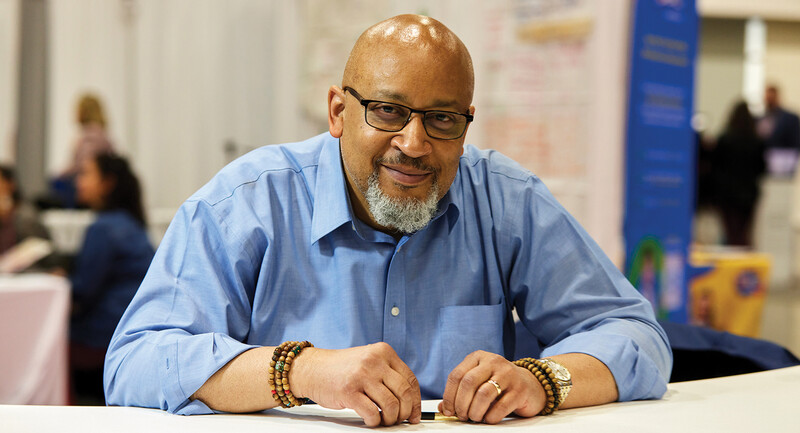The status quo is no longer an option. School leaders need to model care, courage, and open communication.
Credit: MJGRAPHICS / SHUTTERSTOCK
When I started as a superintendent six years ago, a seasoned superintendent in my county gave me some (unsolicited) advice.
He said, "Your job isn't to change anything; it's to maintain the good."
My district is in a suburb of New York City that is considered to have mostly very high-achieving schools. I suppose he was trying to caution me as a new leader against being overzealous, but I was still skeptical of that advice, then and now. To "maintain the good" in a constantly changing world, for one thing, means we haveto change to adapt to new realities. School districts are huge, complicated systems that always (even in the best of circumstances) have a mix of "good" and "needs improvement." Now, especially, with the recent global pandemic and the many stressors on our society and on our children, change is more complex than ever.
So how do we "maintain the good" but also be responsive to new needs and challenges? How do we create a schoolwide culture that embraces change and celebrates successes and includes allour staff and colleagues? I believe there are three fundamental elements that need to be part of any education leader's leadership strategy—communication, care, and courage. They may sound basic, but taken together, they are perhaps the most effective tools we have to lead through change. These three elements were paramount in leading my community through a time of crisis.
In mid-March 2020, when unsettling news of the growing new virus was a daily headline, a parent whom I respect emailed me and urged me to communicate with families more regularly. I had been doing a weekly educational blog, occasional Twitter posts, and some emails about the latest information on COVID-19, but she urged me to communicate more consistently and directly with families in my district. "You are our leader, and in this unsettling time, we need to hear your voice."
She was right. I began emailing the families of my district every day that spring. I didn't start out intending to email every day, but there was so much information to convey at that time that it was necessary. In between the news about what I was hearing from health officials or about information we needed to share for online instruction, I tried to insert some messages of hope and optimism. After the state shut down our physical schools, I told stories of my own struggles in trying to help my two legally blind daughters with their remote schooling while also running the district from my kitchen table. I was honest about how hard it all was, and I was surprised to hear that my emails were giving people support and hope in those difficult days. One of my best-received emails was one in which I related how completely disappointed my daughters were with me as their at-home teacher. I was "kind of boring" and they much preferred their "real" teachers.
That time taught me a lesson about communication that I will never forget. If we as leaders want our constituents to trust us, they need to know who we are. We need to communicate frequently, plainly (not in edu-speak), and, yes, honestly.
I no longer email the families of my district every day, but I do communicate frequently and honestly. In fall 2022, we began work on a five-year strategic plan. We are using a variety of means (both electronic and in-person) to get all our constituents to give us feedback on the direction of the district, and we will use that feedback, even if it isn't always what we want to hear. I believe that the honest communication practiced during the pandemic will help in this new process of long-term planning for our community.
As leaders, especially in crisis, we tend to go into action mode: triage, get the job done, and then compartmentalize to move things forward. That often means holding our emotions in check and addressing problems in a dispassionate way. While I recognize that sometimes logical, rational problem solving is necessary in leadership situations that require immediate solutions, starting with kindness and care in complex missions of change can be a more effective strategy. Care solidifies trust and removes fear, and fear is the enemy of change. The reality is that leaders need to switch gears between problem solving and nurturing. I think more discussion of the latter as a key leadership quality might change the way leaders approach significant change.
When I was a young principal, I tried to get my staff to adopt a new strategy for teaching reading classes. There was buy-in from most of the team, but I was struggling with a particular veteran staff member who was resistant to the change. I tried providing great professional development and, when that didn't work, "mandated" the change for all teachers. But as you can imagine, this only brought more resistance and resentment from this staff member.
One day, out of frustration, I sat down with her and said, "Look, you are an excellent teacher, and I know that you want more than anything to do what is best for your students. You have been doing that for your entire career. How can we work together better?" Before I could say another word, the teacher started to cry. What she said next stayed with me to this day: "I didn't think you had any respect for me. I thought you believed that I was just an old relic who had nothing to share anymore."
I was stunned. How could I have missed that this teacher primarily needed to know that she was valued? Our conversations took a very different turn from that day forward. She still didn't always agree with my ideas, but she tried and adopted way more of them after learning that I sincerely respected and cared about her. We both grew from that interaction.
When we demonstrate respect for the commitment that our staff members have for their work, it places us in a more collaborative position than if we assume that we know better (Fullan, 2011). Sometimes that requires compromise on our part as leaders, but it ultimately moves systems forward more quickly. The political climate of the past few years has created a "crisis of caring," an environment where polarization, meanness, and disrespect are accepted as common discourse. I think school leaders can model the kind of real care and respect, even and especially when we disagree, that may set an example for society as we move forward in this post-pandemic era. I should note this means laying the groundwork of kindness, respect, and compassion before crises occur. By developing caring relationships and behaviors constantly and consistently, we build the trust that allows respect to thrive even when things get rocky.
Today, the well-being of our staff and students may be one of the most important considerations we need to hold in proposing and executing change. The Masai tribe in Africa (O'Neill, 2021) greet each other routinely with a phrase that means, "And how are the children?" The response is, "All the children are well." The Masai recognize something of critical importance: that our communities' strength and wellness can only be judged by the wellness of the most vulnerable among us. We need to lead with care, and to consistently ask, "And how are all the children?"
I did not heed that advice from the superintendent who told me not to change anything. Change takes courage, and it involves risks, and for leaders, those risks are perhaps more consequential. No one wants to propose a change that fails, and it is easy to see why some might choose the "safe" way of maintaining over changing. But we all choose this career to make a difference in the lives of students, and schools, like any institutions, require change to grow. Schools haven't changed as much as they've needed to in the past 50 years. High schools of today look similar to the one my grandmother attended, and yet the world we are preparing students for is very different.
In his book What School Could Be, former venture capitalist and technology innovator Ted Dintersmith (2018) detailed his travels around the 50 states in search of innovative teaching. What he found were courageous teachers and leaders who, despite systemic barriers, implemented change in their systems and created environments where children learned "creatively and joyously." We need more of that courage to transform our schools today.
In my first year as superintendent, I inadvertently learned how courageous one has to be to lead through change. I had been the assistant superintendent for curriculum and instruction for two years prior to being named superintendent. During that time, the curriculum committee had been working on a change to our elementary homework policy. After discussing the latest research on the effects of homework on elementary students (Cooper, 2015; Hattie, 2008; Kohn, 2007), we decided to make some shifts in our homework practices. A growing body of research questions the value of homework at all at the elementary level and certainly supports a reduction in the amount of homework young students have. Conversely, the benefits of increasing the volume of independent reading are clear (NCTE, 2019), and we wanted reading to be the central part of early elementary homework instead of it being what students did when they "finished their work."
So, we eliminated compliance-based worksheets and pages of math problems that most parents couldn't help with, and named our new homework approach WRaP, for wonder, read, and play. We wanted children to have less after-school work and for that work to be primarily composed of reading, curiosity-based activities, and increased free play.
We announced the change to the community in the spring of 2018. Unfortunately, the press got hold of the information and it morphed into headlines like "School District Eliminates Homework!" and "No More Homework for Long Beach Students!" News crews began showing up at our buildings, and parents and staff started to panic that maybe the press was right and we had eliminated homework entirely. My leadership team had to wrestle back the message. Elementary homework wasn't gone; it just looked different.
It would have been much easier as a leader to backpedal the changes to the homework policy that year because of the misrepresentation by the press and subsequent pushback. It took courage from my team to push forward with what we believed was good for our students. We were pressured by many parents, and even some staff, to reverse our planned change or postpone it until the inaccurate press died down. I remember one of our principals saying, "I still think this is the right thing to do, but maybe we should wait until next year."
Our team ultimately continued to press on and kept reaffirming, re-explaining, and reassuring parents and teachers who feared the change. We even invited a local university to "audit" the change and prepare a report for the community during the next year, hoping that the extra transparency would assure doubters. We had made this decision in a principled way based on what we truly believed was best for our students. Our courage paid off in the end: That spring, we had the highest achievement growth in the history of the district in both reading and math at every elementary grade.
As school leaders are increasingly challenged in terms of conversations about equity, content-censoring, and providing for the well-being of students, courage will be a necessary quality in ensuring positive change.
Our students are preparing for a world we cannot yet imagine. How schools respond to the changes our world will bring and to experiences that shape our society will depend on courageous, caring leaders who can communicate well. These types of leaders will lead their school communities to better learning and will ensure the well-being of the students entrusted to their care.
References
•
Cooper, H. M. (2015). The battle over homework: Common ground for administrators, teachers, and parents (3rd ed.). Carrel Books.
•
Fullan, M. (2011). Change leader: Learning to do what matters most. Jossey-Bass.
•
Hattie, J. (2008). Visible learning. Routledge.
•
Kohn, A. (2007). The homework myth: Why our kids get too much of a bad thing. Da Capo Lifelong Books.
•
NCTE. (2019, November 7). Statement on independent reading. Retrieved from https://ncte.org/statement/independent-reading
•
O'Neill, P. (2021). And how are the children? Unitarian Universalist Association.









